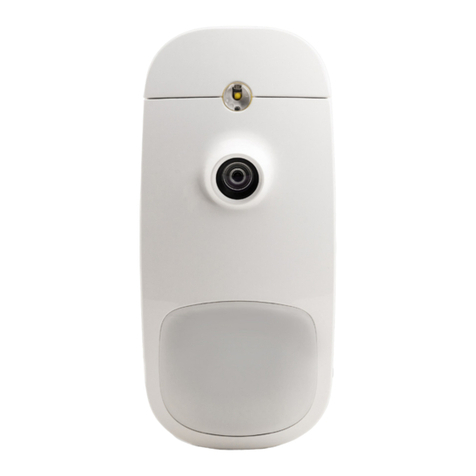
PANIC
You can activate a panic alarm at any time, even if the
system is not armed:
Press and hold down and at the same time.
The siren sounds (depending on conguration, this
function can be deactivated).
An activation alarm is sent to the PhoneWatch Alarm
Receiving Centre.
PROGRAMMABLE
FUNCTIONS
WARNING: The system goes out of programming
mode after 20 seconds if you do not press any keys
during this time, and the red light goes o. If this
happens, you must repeat all the steps.
In programming mode, the user can alter the beep tone
level for all sensors connected to the system (only for units
with beep function) and congure the chime function.
Enter programming mode:
Press and hold down and at the same time.
A double beep sounds and lights 1, 2, 3 and 4 start
blinking.
Exit programming mode:
Press twice.
A double beep sounds and lights 1, 2, 3 and 4 stop
blinking.
Adjust beep tone level on keypad:
Enter programming mode.
Press Away arming button the required number
of times to identify the sensor you wish to adjust the
beep tone level of (each sensor gives a beep as soon as
it is selected).
EXAMPLE: If you wish to adjust the beep tone level for
sensor 2 press the button twice. Sensor 2 gives a
beep to conrm that it has been selected.
Lights 1, 2, 3 and 4 start to blink.
Press a button from to to select the beep
tone level (1 = min., 7 = max.)
The selected sensor gives a beep to conrm the beep
tone level.
Exit programming mode.
Turning the chime on/o:
A chime sounds on the keypad every time you open a
contact sensor eg. front door.
Enter programming mode.
Press the Home arming button.
Lights 1, 2, 3 and 4 start to blink and there is a long
beep.
Press to turn the chime on or to turn the
chime o.
There is a long beep.
Exit programming mode.
INDICATOR LIGHTS
The keypad has indicator lights to show the status of the alarm system.
LIGHT 1 LIGHT 2
LIGHT 3 LIGHT 4
Lights 2, 3 and 4 indicate faults that are in the memory. The lights are only active when the system is not active and
during the arming and disarming phases. When the system is armed, the indicator lights go o after a few seconds.
LIGHT 1“SYSTEM ARMED”
ALIGHT: The entire system is armed (Away).
BLINKING SLOWLY: Part of the system is armed (Home).
OFF: System is disarmed.
LIGHT 2“SYSTEM FAULT”
ALIGHT: There is a fault in the system.
Faults include battery or power failure, signal transmission failure, GSM/GPRS failure. If this light
stays on, contact PhoneWatch.
BLINKING SLOWLY: There is a fault registered in the system’s memory that must be reset.
OFF: No fault.
LIGHT 3“ALARM ACTIVATED”
ALIGHT: The alarm has been activated or a sensor in the system has been activated. This
includes opening a door contact, a motion sensor or a smoke alarm sensor.
BLINKING SLOWLY: There is an alarm activation registered in the system’s memory that must
be reset.
OFF: No alarm activation.
LIGHT 4“TAMPER WARNING”
ALIGHT: There is a tamper alarm on the system.
BLINKING SLOWLY: There is a fault registered in the system’s memory that must
be reset.
OFF: No tamper message.
Note: See page 7 for resetting system after activation.
89




























